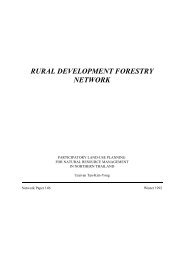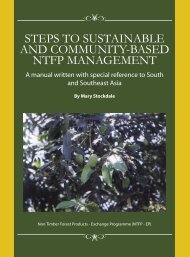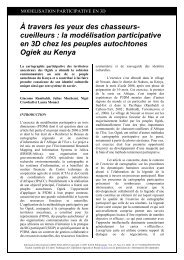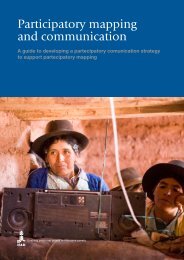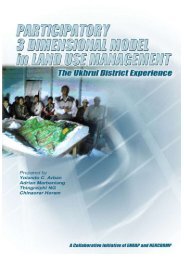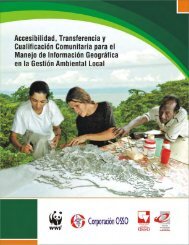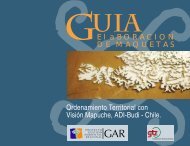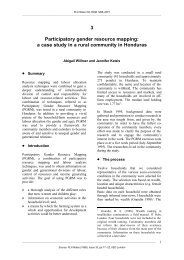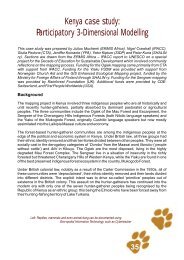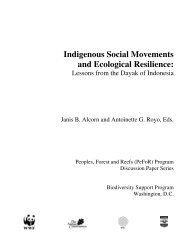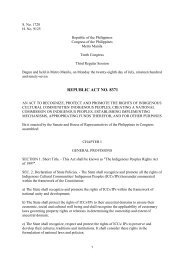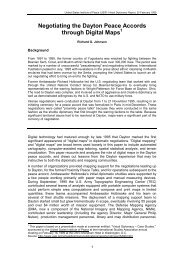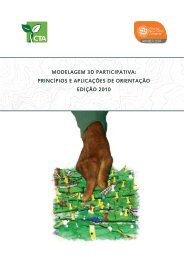Create successful ePaper yourself
Turn your PDF publications into a flip-book with our unique Google optimized e-Paper software.
8. Village<br />
action plan<br />
8.3<br />
Some lessons from<br />
Viengkham District<br />
Preliminary lessons can be drawn from these first villages in<br />
Viengkham District where the village action plans where collectively<br />
designed.<br />
An innovative way to respond<br />
to villagers’ demands<br />
The extension activities are collectively defined after a 5-day diagnostic<br />
and planning process which allows extension staff to<br />
better understand the local issues. Alternative scenarios are envisioned<br />
by the local community to overcome the problems collectively<br />
identified. Thus the extension staff are in a position to<br />
accompany the local community along the development pathway<br />
they have decided by themselves. This process avoids proposing<br />
technical options that may be irrelevant to local circumstances.<br />
Integration of Land Use Planning<br />
and extension activities<br />
Since the Village Action Plan is a demand-driven extension process<br />
not all activities proposed can be addressed by a single<br />
project. In each village, the facilitators systematically review<br />
the activities proposed to define which are manageable by villagers<br />
using their own resources, which can be addressed by<br />
existing projects within a reasonable timeframe and finally,<br />
which have to be postponed due to limited resources. The latter<br />
activities can be reactivated at any time when a new project<br />
comes to respond to the development issues identified by the<br />
villagers themselves. Ideally, a consortium of development projects<br />
would be coordinated by DAFO staff to tackle the issues<br />
defined and prioritized by the villagers themselves.<br />
Village Action Plan as catalyst<br />
of a Land Use Plan<br />
The Village Action Plan is an essential component of the PLUP<br />
as the activities proposed are expected to engage local communities<br />
in implementing their land use plan. It is therefore<br />
important (i) to allocate sufficient time in order to formulate<br />
the Village Action Plan and (ii) to involve the same group of<br />
villagers who participated in the land use zoning process in the<br />
follow-up extension activities. But in addition to the involvement<br />
of the VLMC members it is important to provide time and<br />
space for broader village consultations involving all the households<br />
and relevant projects.<br />
A Village Action Plan committing the village communities and<br />
DAFO staff to go beyond individual projects can play a role in<br />
integrating development activities with the multiple projects<br />
that support DAFO. The impact of development interventions is<br />
increased when village communities follow their own planned<br />
development pathways in addressing the village priority issues.<br />
It is important to involve both villagers and extension agents in<br />
the monitoring of the land use plan (including Village Action<br />
Plan) to ensure that the agreements made during the planning<br />
sessions are effectively translated into concrete actions.<br />
EXAMPLE<br />
ture land use of their village during the PLUP process, discuss<br />
concrete development In Nam activities Xoy village, that would the help villagers to implement wished<br />
the land use plan to over grow the broom next ten grass years. in The an area facilitator they who had<br />
is also a member planned of the DAFO for permanent extension crops staff review during each the<br />
land use type and zoning the corresponding process. However plots on without the village fencing,<br />
participants broom grass to propose may relevant be damaged activities by<br />
3D<br />
model, inviting the<br />
to convert their land large use ruminants, plan into actions. and The bamboo technical fences staff<br />
can also propose activities are not strong that may enough be unknown to prevent to villagers, these<br />
provided that those animals activities from help destroying to overcome the the crops problems after<br />
identified during the some Problem years Census (broom Session. grass is harvested<br />
over a long period, i.e. more than 10<br />
The facilitator’s role years). is to ease Therefore the discussions villagers between asked villagers<br />
and district technical port from staff Agrisud and to mobilize to construct the knowledge stronger of<br />
sup-<br />
village issues gained fences through from the barbed diagnostic wire. phase to suggest<br />
locally appropriate solutions. For each activity, possible support<br />
- In Houay Kou village, one of the limiting<br />
factors of agricultural intensification<br />
from DAFO or other projects are discussed. At the end of the<br />
session a common agreement is reached regarding the priority<br />
is the water supply. The existing water<br />
activities for the first years of the land use plan. Whenever necessary,<br />
the facilitator may design certain participants to take<br />
system is defective and there is not<br />
enough water for gardening and for livestock.<br />
In the present situation, the most<br />
charge of follow-up activities.<br />
urgent activity for the village would be to<br />
improve the water supply system to unlock<br />
other development activities.<br />
HANDBOO K - Village action plan<br />
Participatory Land Use Planning (PLUP) HANDBOOK<br />
23



